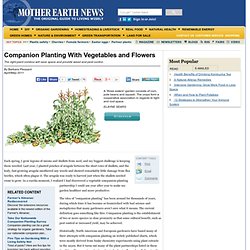

Companion Planting Chart. Companion Planting With Vegetables and Flowers - Organic Gardening. Each spring, I grow legions of onions and shallots from seed, and my biggest challenge is keeping them weeded.

Last year, I planted pinches of arugula between the short rows of shallots, and the leafy, fast-growing arugula smothered any weeds and showed remarkably little damage from flea beetles, which often plague it. The arugula was ready to harvest just when the shallots needed room to grow. In a eureka moment, I realized I had discovered a vegetable companion-planting partnership I could use year after year to make my garden healthier and more productive. The idea of “companion planting” has been around for thousands of years, during which time it has become so besmirched with bad science and metaphysics that many gardeners aren’t sure what it means.
The current definition goes something like this: Companion planting is the establishment of two or more species in close proximity so that some cultural benefit, such as pest control or increased yield, may be achieved. Measuring Success. Vegetable companion gardening. Companion Planting. Home > Companion gardening Companion planting and combining means growing plants together that like or benefit each other.

Vegetable companion gardening can have a real impact on the health and yield of your plants. In nature everything interacts to create a whole life force. This is a basic understanding... that everything organic and living has a mutual influence on every other living thing. Every plant has an effect on every other plant and every creature has an effect on every other creature. Over time, gardeners have observed these interrelationships, and scientists have studied them. It’s well worth while reading a little bit about how and why companion planting is so important before we get into which specific plants go with what. . . .
Plants, unlike many people, are not timid. Nature's Way of Companion Planting The companion effect happens naturally in the wild. Just like us, life's too short for putting up with bad conditions... so aim for the good life for your plants too! Uh oh... Companion Planting. Companion Planting. Plant companions. Homestead Series: How To Plant Potatoes, Start To Finish. Homestead Series Building A Potato Hiller. How to Grow The Top 10 Most Nutritious Vegetables in Your Garden. By Colleen Vanderlinden Treehugger A perfectly ripe, juicy tomato, still warm from the sun.

Sweet carrots, pulled from the garden minutes (or even seconds!) Before they’re eaten. Growing your own vegetables is one of those activities that balances practicality and indulgence. And don’t let the lack of a yard stop you – all of them can be grown in containers as well. 1. Broccoli is high in calcium, iron, and magnesium, as well as Vitamin A, B6, and C. How to Grow BroccoliGrow Broccoli in Containers: One broccoli plant per pot, pots should be 12 to 16 inches deep.What to Watch Out For: Cabbage worm. 2.
There is nothing like peas grown right in your own garden – the tender sweetness of a snap pea just plucked from the vine is unlike anything you can buy in at a store. How to Grow PeasGrow Peas in Containers: Sow peas approximately 2 inches apart in a pot that is at least 10 inches deep. 3. 6 Perennial Vegetables Produce Year After Year. Traditional backyard gardens tend to be full of annual vegetables that need to be started year after year from seed, and while those veggies can be well worth the time and labor it takes to grow them, planting some perennial vegetables in your garden and yard can end up putting food on your plate for far less effort.

Unless you live in a region with a year-round growing season, your tomatoes and peppers (which are perennial by nature) will need to be planted anew each spring, because they can't handle the cold temperatures of winter, but there are other vegetables that can overwinter in many places and spring back to life as soon as soil temperatures are warm enough. By dedicating a garden bed or two to perennial vegetables, especially in a polyculture with other perennials, you can pack a lot of food production into a small area. 6 Perennial vegetables that keep on giving, year after year: 1. 2. 3. 4. 5. 6. Mpanion Plants : Gardenstuff Flowers, Herbs and Vegetables, All the wildflower, flower, herb and vegetable seeds you will ever want, the best range for sale online in New Zealand.
Companion Planting. 17 Apart: Growing Celery Indoors: Never Buy Celery Again. Remember when we tested and shared how to grow onions indefinitely last week?

Well, at the same time, we've been testing out another little indoor gardening project first gleaned from Pinterest that we're excited to share the successes of today — regrowing celery from it's base. We've figured out how to literally re-grow organic celery from the base of the bunch we bought from the store a couple weeks ago. I swear, we must have been living under a rock all these years or just not be that resourceful when it comes to food, but we're having more fun learning all these new little tips and tricks as we dive deeper into trying to grow more of our own food.
This project is almost as simple as the onion growing project — simply chop the celery stalks from the base of the celery you bought from the store and use as you normally would.